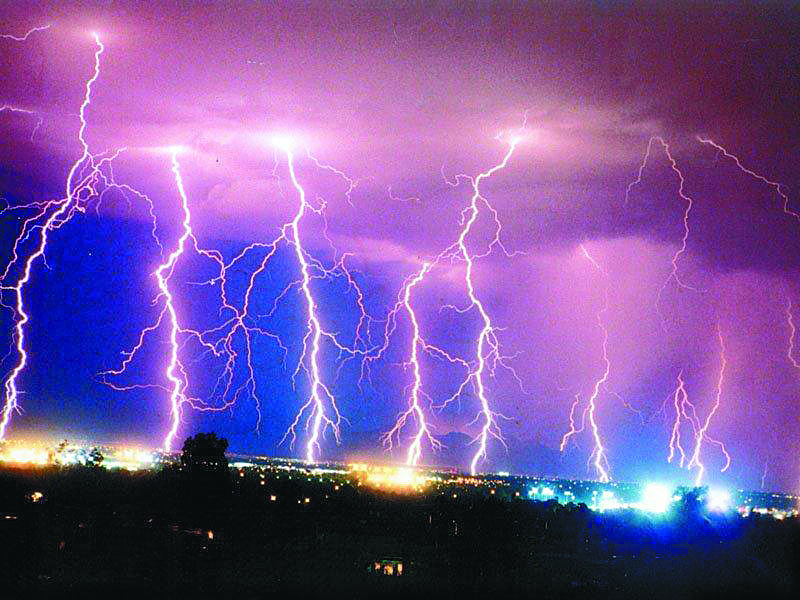|
|
Our Solar System's Giant Storms
Earth's Weather Seems Tame When Compared to Other Nearby Planets
by Pallav Regmi, age 12
 You have undoubtedly heard of hurricanes on Earth, but have you ever heard of tornadoes on Mars? It may sound far-fetched, but tornadoes and hurricanes happen in many places all over the universe.
You have undoubtedly heard of hurricanes on Earth, but have you ever heard of tornadoes on Mars? It may sound far-fetched, but tornadoes and hurricanes happen in many places all over the universe.
On Earth, hurricanes and tornadoes mainly occur in the spring and summer, because warm air affects their formation. A hurricane forms when air from Africa moves towards the Atlantic Ocean. Warm air always rises, and in this case, it collects over the ocean.
As a mass of warm air moves toward the United States, it starts to spiral in a clockwise direction, and the air pressure drops. However, this storm system can only be called a hurricane after it exceeds 38 mph.
A tornado forms when two air masses of a different temperature and humidity meet. This makes the troposphere, part of the lowest layer of the atmosphere, unstable. The upward movement of warm air creates a spiral when rising, and the spiraling intensifies.
Only a small percent of these types of weather systems become catastrophic tornadoes. If you have ever experienced a hurricane or tornado, you probably know that no matter how small they are, they are dangerous and look threatening.
Although tornadoes and hurricanes are dangerous, storms on Earth are nothing compared to what happens on the giant planets.
On Jupiter there is a continuous storm called the Big Red Spot. Scientists are not sure when it started, but it has been raging for more than 300 years. It was first sighted by 17th century astronomers. It is still active today. Estimated to be spinning at a speed of 270 mph, the Big Red Spot on Jupiter is 15,400 miles across, nearly twice the size of Earth.
Astronomers hypothesize that the storm may merely be the top of a gigantic tower of gas that extends from the interior of Jupiter. This storm is considered to be an anti-cyclone, meaning that the storm’s air pressure is high and it spins in a counter-clockwise direction. Observation of the Big Red Spot shows that it always remains south of Jupiter’s equator.
Saturn also experiences very large storms. In 2004 the Cassini spacecraft revealed oval shaped, anti-hurricanes over the southern hemisphere of Saturn that were powered by the planet’s interior.
Another storm on Saturn, which was also discovered in 2004, the Dragon Storm, puzzled scientists. The Cassini spacecraft detected strong radio emissions from one region of Saturn. The spacecraft only picked up radio bursts when the storm was appearing on the planet’s dark side. As soon as it moved into sunlight, the emission stopped. Now scientists think the Dragon Storm is a vast thunderstorm, with radio emissions occurring because of high voltage thunder strikes.
Two of our solar system’s outer planets pose interesting questions for space scientists.
Uranus lacks a significant internal heat source, but Neptune radiates three times more heat than it receives from the sun. The cause of this heat on Neptune is still uncertain, but it is most likely energy left over from its formation.
In Neptune’s atmosphere, there are several storm systems. The largest one was revealed by Voyager 2 in 1989, and it was named the Great Dark Spot. The Great Dark Spot spins counter-clockwise at a speed of 684 mph. While it seemed at first that the Great Dark Spot was spinning unusually fast, it is actually normal for winds to exceed 1000 mph on Neptune. The Great Dark Spot appeared to have vanished by the 1990’s when the Hubble Telescope was unable to locate it.
It seems amazing that any storm could actually be twice the size of our Earth. The fact that weather on other planets in the same solar system can behave so differently from what we experience on Earth is an interesting phenomenon. Scientists are working hard to solve these mysteries.
[Sources: Wonders of the Planets; Discover]
|
|

